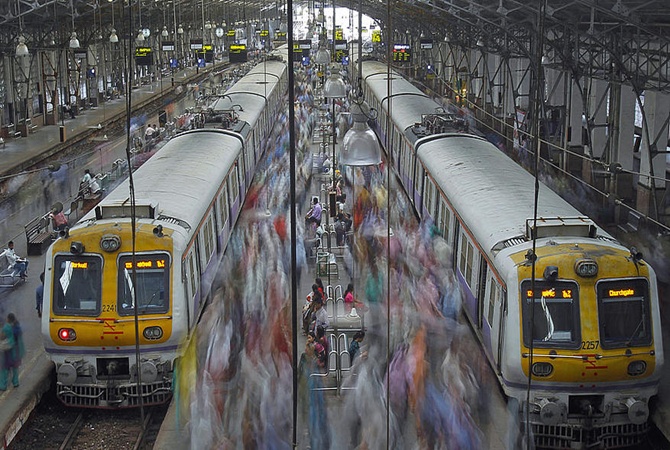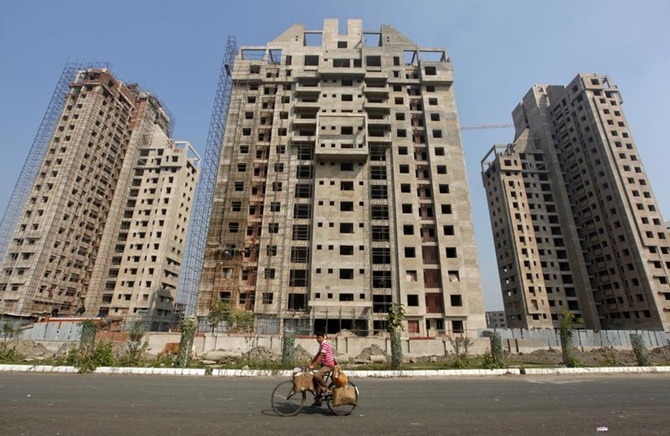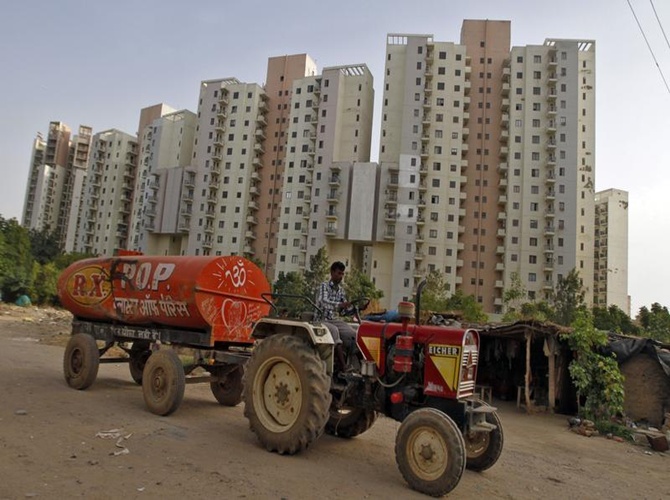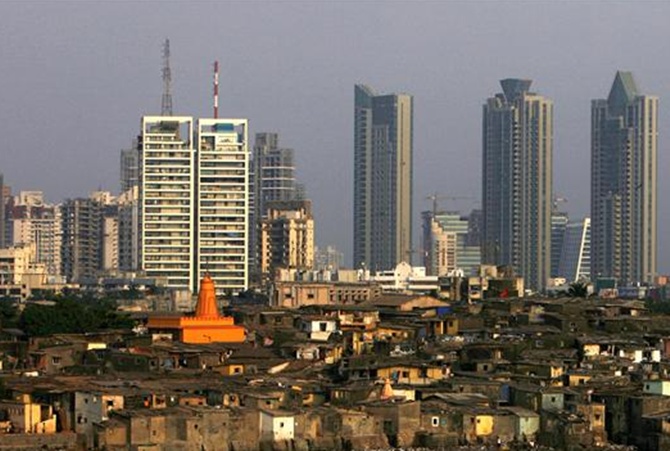Photographs: Punit Paranjpe/Reuters Nitin Desai
One cannot see how the continued unfinished and slum-like environment of our cities can be tolerated in a middle-income India, says Nitin Desai.
Between 2010 and 2050 India is expected to add about 500 million to its 2011 urban population of 377 million.
This means that even at the present grossly inadequate scale of provisioning, urban housing and infrastructure of water supply, energy and transport will have to more than double.
Allow for some necessary improvement in standards and the scale of expansion will be much more.
The panel set up to examine urban infrastructure costs has put forward a 20-year bill of Rs 39 lakh crore, with expenditure as a proportion of GDP rising from 1.6 per cent in 2010-11 to 2.1 per cent in 2030-31. And this does not include urban housing.
However, the central issue is not the finances required but the readiness of our urban governance and management systems to cope with the challenge of growth and of upgradation.
One cannot see how the continued unfinished and slum-like environment of our cities can be tolerated in a middle-income India.
…
How India can build world class cities
Image: Local trains in Mumbai.Photographs: Reuters
Three major changes are required to cope with the challenge: radical reform of the urban land market so that transparent transactions and rational land use are facilitated; comprehensive reconsideration of building codes and planning restrictions to encourage more compact, less transport- and energy-intensive cities; and decentralisation and empowerment of city administrations so that space is created for entrepreneurial city leadership.
Cities are shaped by the efficiency with which the urban land market functions. Our urban land markets are dysfunctional.
They are opaque and do not encourage the optimal use of land. In major metropolitan centres, much of the re-developable urban land is held by urban authorities or some public sector entity such as the railways, the port trust or the defence ministry.
…
How India can build world class cities
Image: A man passes by residential buildings in Kolkata.Photographs: Rupak De Chowdhuri/Reuters
The effective use of this land depends entirely on the public sector's capacity to mobilise resources and implement projects efficiently, both of which are sadly deficient at present. Private developers trying to work to scale have to leapfrog beyond city limits into peri-urban areas.
But they, too, often sit on land banks so that new entrants move even further out. We end up with a patchwork of sprawling development, with vast vacant areas in between. This leads to unnecessary costs for infrastructure and transport.
We need more compact cities from an environmental perspective and to reduce the costs of municipal and transport infrastructure. Publicly held lands must be put on to the market so that they can be developed more rapidly.
…
How India can build world class cities
Photographs: Reuters
Developers should be charged betterment levies that truly reflect the additional cost of their particular location.
And, of course, land records need to be cleaned up; a system of standard prices for land transactions has to be established; and the fiscal system must encourage greater transparency in transactions.
The other big issue in this area is land acquisition. When urban authorities put in infrastructure, like a ring road, they usually acquire the land through an acquisition process that compensates the losers on the basis of the value of land in its earlier use.
Other landholders whose lands will benefit in value from the infrastructure become the big gainers.
This inherently unfair system should be replaced with a land adjustment procedure that involves an agreement among all affected landholders to surrender part of their land for the infrastructure and get back readjusted plots in proportion to their original holdings.
In such a land adjustment process, all landholders, including the ones whose actual plots will be wholly required for the infrastructure, share in the increase in value.
…
How India can build world class cities
Image: High rise buildings are seen behind a slum in Mumbai.Photographs: Arko Datta/Reuters
This procedure should also be used for larger-scale property development - at present developers acquire land at agricultural rates and then, in connivance with the authorities, get the use changed and appropriate the resulting increase in value.
Reforming urban land markets to loosen the supply of land will have to be accompanied by a reconsideration of some of the planning restrictions such as the use to which each plot can be put, the extent of built-up area, height restrictions on construction and so on.
The scale of urbanisation ahead of us, the costs of urban infrastructure, and environmental imperatives like minimising emissions require us to look to more compact cities with more high-rises and a mix of commercial, industrial, residential and leisure facilities within easy reach of one another.
Our master plans do not encourage this sufficiently, and we need to examine land use and planning restrictions so as to discourage sprawl and encourage a much more rational use of land.
…
How India can build world class cities
Image: A shepherd with his herd of sheep waits for the signal at a busy road junction in Noida on the outskirts of New Delhi.Photographs: Reuters
The third, and in some ways the most important, element in urban reform is governance.
Our city administrations are virtually powerless and the ministries in the state capitals take all the crucial decisions on finance, spending and planning.
By 2050, the bulk of our GDP will be generated in cities and it is absurd that they should not have fully empowered local governments with full authority over planning and spending and the fiscal capacity to finance this spending.
The interaction of the city with the hinterland beyond its boundaries will, of course, be managed by the state administration, but it should avoid interfering on matters that affect only the city.
The ingredients of effective city governance are many: an entrepreneurial mayor (possibly directly elected), local committees to give a more direct voice to citizens at the community level, transparency in decisions about land use changes that alter values, open information on contracts, and so on.
…
How India can build world class cities
Image: A local passenger train passes-by cows at a railway station in Mumbai.Photographs: Danish Siddiqui/Reuters
What stands in the way is the unwillingness of state-level politicians to let go of the huge money-making opportunities that arise from planning decisions.
Perhaps some further tweaking of the 74th Amendment to the Constitution, which sought to empower urban local bodies, may be needed.
As far as independence in financing is concerned, there is no reason why cities, where the bulk of our GDP will be generated, cannot raise enough money from property taxes, betterment levies on developers, municipal bonds and other such means to be largely independent of state or central financing.
We have not even started on the reform agenda outlined here. Any further delay will mean that in 2050 a middle-income India will continue to live and work in low-income cities.









article